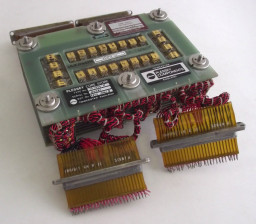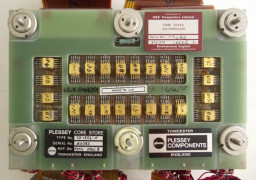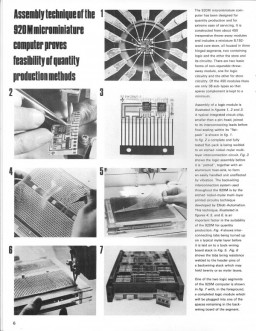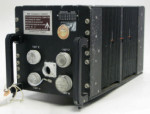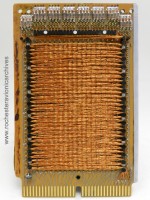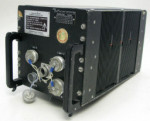The 920 series of computers was developed at Elliotts Borehamwood Computing Division in the 1960’s and was derived from the successful 901 commercial computer which was miniaturised for airborne use. One of the primary production derivatives was the MCS 920M which was used in the
Jaguar Navigation and Weapon Aiming Sub-System NAVWASS This system comprised the MCS920M central digital computer, E3R inertial platform, projected map display and horizontal situation indicator together with the necessary power supply, electronic, interface and control units.
The MCS 920M is a microminiature general purpose digital computer using flat pack integrated circuits and. has a random access, 8192 word, 18 bit ferrite core store with a 2microsecond cycle time. Elliotts lacked access to multi-layer printed circuit board technology so used a special technique developed at the Borehamwood Computer Laboratory (see ‘Moving Targets’ by Simon Lavington). The box is unusual in that it folds out into three blocks.
In addition to performing navigation and weapon aiming calculators, the computer caters for in-flight monitoring, initial alignment and in situ first line system testing. The Computer also had an Interface Unit which enables the digital computer to receive and transmit information from and to other units in the aircraft in compatible signal form. The Interface Unit also supplied the power for the computer and Navigation Control Unit.
In its production form the MCS920M was widely used in its intended role in the Jaguar navigation attack system and eventually grew to a 64 K machine. The 920M also saw use in the ELDO rockets.
The MCS920M was also adopted for a number of naval inertial navigation applications.
Thanks to Terry Froggatt we have two pages of how a 920M is built.
The two pages shown look very like the Core Stack photos (minus a top plate) catalogued as C1059.
We assume an Elliott typo (not uncommon), for "7 epoxy-glass printed circuit boards" read "9 epoxy-glass printed circuit boards" There are 24 chips in the Core Stack and a pair of 24-way ribbon cables. Possible explanation:
“8192 words is not a square number. On a 920B/903 the store is addressed as two 4096-word stores, so there are 64 "Y" address wires running though ALL 8192 words, and 64 "X" address wires running through EACH 4096 words.
Total 192 wires, = 24 * 8, (and each wire needs 4 diodes).
So, your core store may well be a spare for a 920M, or perhaps from a 920M "extra store" module, or a 920C.
See: http://www.computerconservationsociety.org/software/elliott903/more903/Manuals/index.htm this gives copious links to the 920 Computer family.

